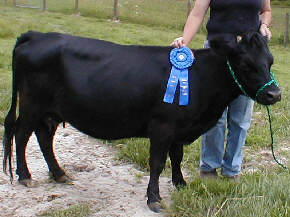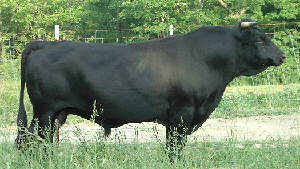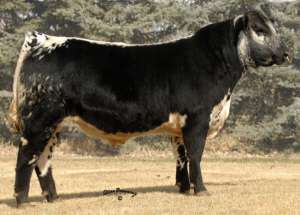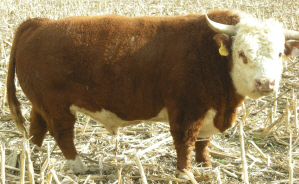



Dexter
History
The Dexter originated in the South Western region of Ireland where they were originally kept by small landholders and known as the "poorman's cow". Like the Kerry, they are descended from the predominately black cattle of the early Celts.The frequently heard theory that the Dexter are a comparatively new breed is a complete fallacy as the breed is fully described and mentioned by its proper name, in a report on Irish cattle written in 1845, by Mr David Low.
From this publication it is noted that the breed owes its modern appearance, name, and probably qualities to a Mr Dexter who was agent to a Lord Howarden who came to Ireland in 1750 and made his home in Co Tipperary. David Low stated that a Mr Dexter had produced his curious breed by selection from the best of the hardy mountain cattle of the area, and to have succeeded to a very high degree.
At the turn of the 20th century, Dexters became the show cattle of the English gentry. As the 20th century progressed, Dexter numbers declined. In the 1970s, they were designated as rare and endangered. More recently, their attractiveness to small landholders has seen a significant increase in their numbers globally. As a result, the Dexter is the best example of a domestic cattle breed saved from extinction.
Characteristics
 Photo courtesy of Freedom Farm Dexters, www.freedomfarmdexters.com |
The breed comes in three colours, predominately black, but also red and dun. Most are horned although a very few naturally polled animals are becoming available.
Dexter cows are extremely maternal and because of their dual purpose qualities will milk well. Calving problems are rare and newly born calves are up on their feet very quickly with calves weighing 25-35 pounds at birth.
Heifers mature young and can be put to the bull at 15 - 18 months of age. Dexters are noted for their longevity and can live up to 25 years and should breed regularly for 14 years or more.
The breed is early maturing. Beef of excellent quality and flavour, with good marbling, can be produced economically. Dexter steers can finish on grass at 20 -24 months of age without supplementary feeding, with average carcase weights of between 145 - 220 Kg's. Because their good meat to bone ratio, a killing-out percentage of over 56% can be achieved.
Milk yields vary as to whether the cows are kept for dairy cows, sucklers or house cows. For instance, the average daily milk yield for a house cow will be some 8 - 10 litres (2450 - 3050 litres per 305 day lactation). A cow kept as a suckler will raise its own calf as well as a larger commercial calf and do them both well. Dexters kept as dairy cows will yield on average, 10 - 12 litres daily (3050 - 3660 litres per 305 day lactation), with some individuals yielding 14 litres or more (4080 litres per 305 day lactation).
The milk is of very good quality with high butterfat and protein levels; average BF % is well over 4% and protein 3.51%.
Mature cows can be successfully crossed with most native beef breeds, and will produce excellent fast growing progeny. Care must be taken if a continental bull is to be used. Ensure the bull has an easy calving record, and that cows are 'fit' and not overweight at calving.
The breed's ability to adapt to varying and extreme climatic conditions and to different systems of management is a typical characteristic.
Not only can a Dexter be the ideal family cow/pet, but, pound for pound, they are far more economical than their larger counterparts. More Dexters can be grazed on less acreage; they produce high percent dressed carcass of lean, tender, fine-grained beef with excellent flavor. as dairy cattle, their milk is easily digested and high in butterfat - yielding 1.5-2 gallons of 4% butterfat milk per day - with smaller-sized fat globules making the milk more digestible.
Statistics
 Photo courtesy Sweet Dream Farm, www.sweet-dream-farm.com |
- Small
- Hardy - Dexters are good browsers and were sometimes used to rid pastures of pest plants. They were specialised to live on low-quality vegetation and to forage for their food.
- Efficient
- Versatile
- Intelligent
- Full of personality - Dexters are also kept for pets too.
- Multi-purpose breed
- Great milk and beef
- Easy calving - can also raise two calves at a time
Comparative
Distribution
Dexters have established themselves well in many parts of the world. They have been exported to Australia, New Zealand, America, Britain, Cuba, Argentina, Kenya, Zimbabwe, Italy, Belgium, Denmark and Germany. Several of these countries have their own breed societies, which only goes to show how well the breed has become established worldwide.References (the above information was cited from the following sites)
www.dextercattle.co.uk
www.dex-info.net
www.freedomfarmdexters.com
www.sweet-dream-farm.com


